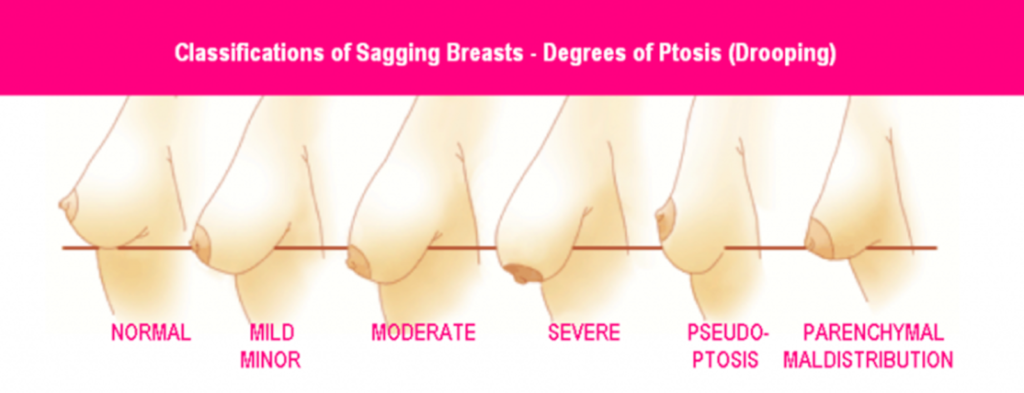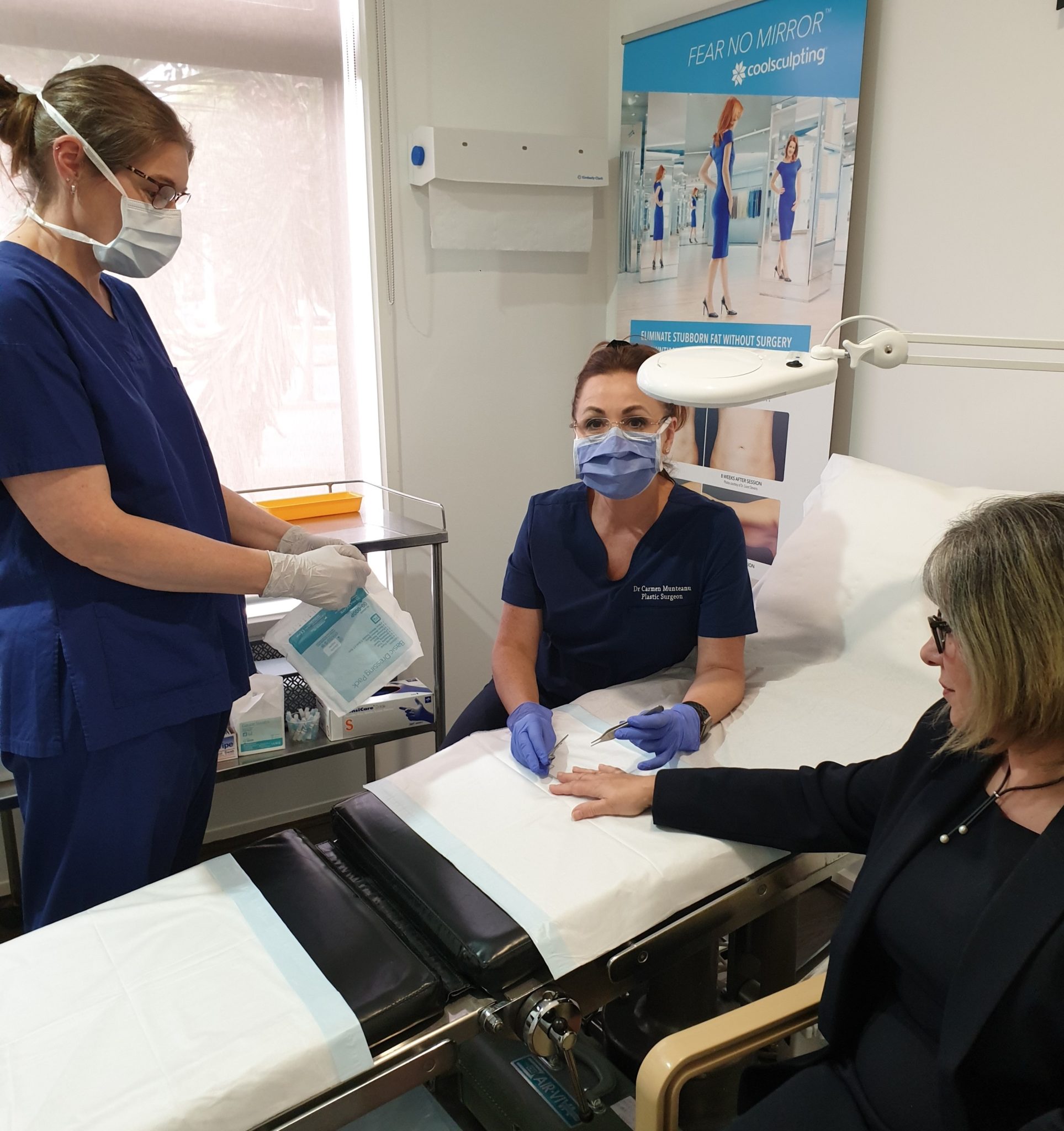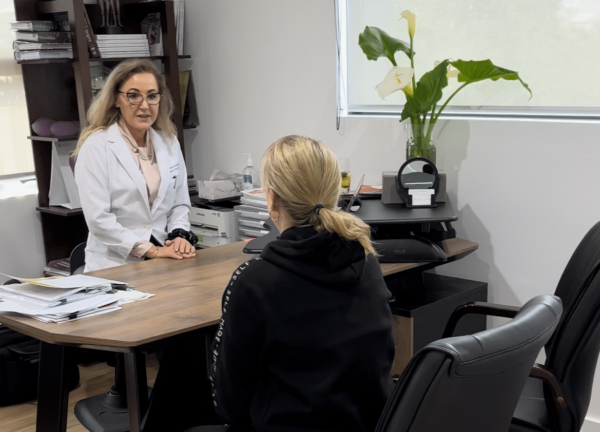Surgical Solutions for Sagging or Drooping Breasts? – Understanding Breast Ptosis
One of the most common problems that women suffer from as they age is breast ptosis (also known as breast drooping). This is when your breasts become saggy and lose their normal position and “perkiness” after pregnancy or weight loss. If you have droopy boobs, your nipple might also start pointing downward. For many women, saggy breasts look deflated, making them feel unattractive, and just don’t fulfil their perceived body image. Throughout life, women can go through a lot of physical and physiologic changes like pregnancy, breastfeeding, or weight fluctuations, which can all take a toll on their bodies. Dr Carmen Munteanu in Melbourne has years of experience in treating breast ptosis. She offers women who want to fix their droopy breasts several options. Saggy boobs can be treated with a breast lift (mastopexy), breast augmentation (implant), or a combination of both. Keep reading to learn more about breast ptosis and how you can fix it
Download Dr Carmen’s Guide to Cosmetic Breast Surgery
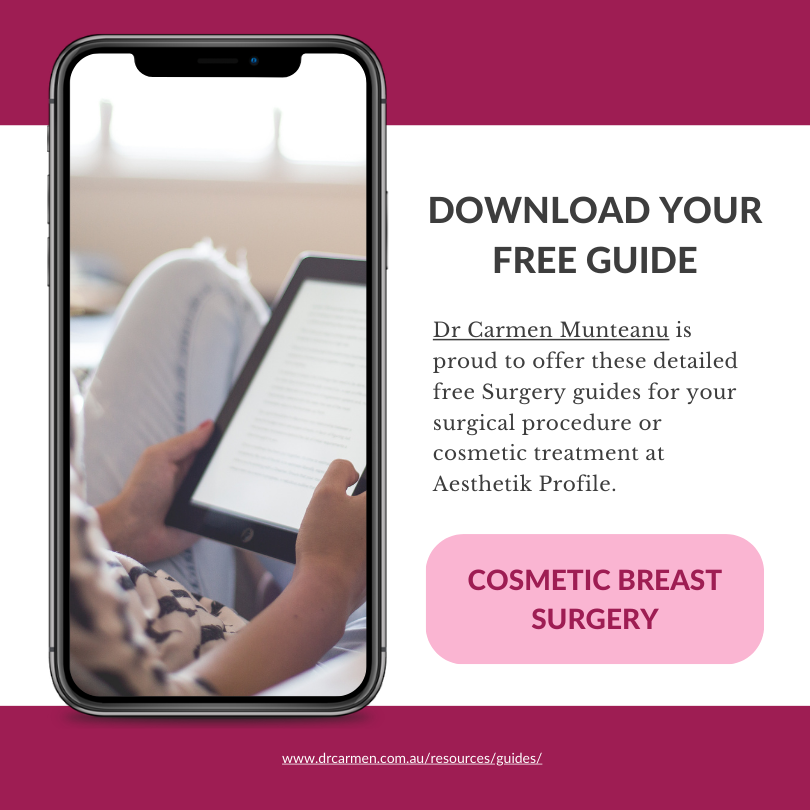
What is breast Ptosis?
Breasts ptosis is the medical term used by plastic surgeons to describe saggy or droopy breasts. This is when your breasts hang down from their normal position. It’s usually associated with lax skin, loss of breast volume, and downward-facing nipples. The breasts are composed of fat, breast tissue, and an intricate network of connective tissue that holds everything together called the cooper ligaments. You can think of the cooper ligaments (suspensory ligaments of cooper) as a web of fine -yet tight- cords that run through your whole breast to give it its firm shape. Due to a number of reasons, such as weight change, pregnancy, or ageing, the cooper ligaments holding your breasts in position might stretch and become weak, so they start dropping and losing firmness. This, in association with loss of skin elasticity, leads to breast ptosis.
What causes breast ptosis?
Age is important when it comes to boob droop, however, it’s not the only factor. Some women might get droopy breasts in their late 20s, while others might keep their firmness till menopause. Several factors play a role in determining how soon you develop deflated droopy breasts and how severe the changes are. Here are some of the causes of breast ptosis:
- Gravity: All your life, gravity is pulling your breasts down and slowly stretching your cooper’s ligaments and your skin. It’s one of the main (and, sadly, unavoidable) factors that lead to breast ptosis.
- Breast size: Larger breasts tend to become saggy earlier and the changes are more noticeable compared to smaller breasts. The larger your breast volume is, the more gravity affects it, and the more boob ptosis you develop. This applies to women who naturally have large boobs and those who are obese or overweight and have a lot of breast fat.
- Weight fluctuation: Rapid weight loss or weight gain can change your breast size, stretching your skin and ligaments
- Smoking: Numerous studies have shown that smoking reduces skin elasticity, which may contribute to more breast drooping
- Pregnancy: When you become pregnant, the hormonal changes will cause your boobs to become bigger. This stretches your skin, and the effects are usually more apparent if you’ve had more than one pregnancy.
- Genetics: Your genes play a role in determining how elastic your skin is, how firm your boobs are, and how strong cooper’s ligaments are. If you naturally have lax skin, you’ll be more likely to develop more severe breast ptosis.
- Age: Every woman will reach a certain age where she’ll eventually start having droopy breasts regardless of all the other factors. This is just how our body works; our skin stretches and our ligaments become weaker as we age, and there’s no way to prevent this. Boob droop can start at any age, however, it’s more likely to start after reaching menopause.
Does breastfeeding cause breast drooping?
Well, according to the American Society of Plastic Surgeons, breastfeeding is an important contributor to breast ptosis, however, there aren’t any concrete studies to support this. By the time you give birth, your breast tissue will have developed and grown to allow you to produce milk for breastfeeding. After weaning, a process called “involution” starts, and it aims to restore your pre-pregnancy breasts. Since you’re no longer breastfeeding, your milk ducts will shrink, and your breast tissue becomes smaller, however, the skin around your breast might remain stretched. If this happens, you’ll end up with saggy and deflated breasts.
How is Breast Ptosis measured?
There are several types and degrees of droopy boobs. Plastic surgeons usually use the Regnault classification of breast ptosis to classify your condition. This classification takes into consideration the location of your nipple in relation to your inframammary crease and lower breast pole. The inframammary crease is the skin crease right under your boob where it blends with your chest. The lower your nipple is, the more severe your ptosis is. Here’s the Regnault classification:
- Grade I: Minor ptosis – Your nipple is directly at the level of the inframammary crease
- Grade II: Moderate ptosis – Your nipple is below the level of the inframammary crease, but above your lower breast pole
- Grade III: Severe ptosis – Your nipple is below the level of the inframammary crease, and on the lower breast pole
- Pseudoptosis: Your nipples are in a normal position but the rest of your breast is deflated and hanging down below the inframammary crease
- Parenchymal maldistribution: Your nipples are in a normal position but the rest of your breast is hanging down below the inframammary crease
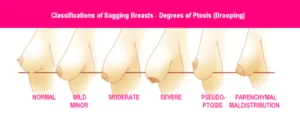
Depending on the severity and type of breast ptosis and the elasticity of your skin, Dr Carmen will determine which surgical approach is best for you.
How can you fix sagging breasts with surgery?
Dr Carmen offers several surgical procedures to treat saggy droopy boobs. These procedures aim to restore the normal higher position of your nipples, tighten your skin, and pump up the volume of your deflated breasts. The aim is to create perky boobs that look and feel as young and natural as possible. For this purpose, Dr Carmen usually recommends mastopexy (breast lift), breast augmentation (implants), or both a lift and an implant together:
- Mastopexy (breast lift): Breast lifting is for you if you have saggy breasts with stretched skin, but your breasts still have enough breast tissue to give you good breast volume. During this procedure, an incision is made around your nipple (periareolar incision), and it might be extended vertically to the lower pole of your breasts. Dr Carmen will cut out the excess stretched skin from the bottom of your boobs and then reposition your nipples higher up in their normal position. The remaining breast skin is then pulled together tightly to produce perky and firm boobs.
- Breast augmentation (implants): Breast augmentation, can alone be enough to treat some cases of breast ptosis in women with deflated saggy breasts. Inserting breast implants alone can make your boobs perky and push your nipples upward into a normal position without needing a breast lift. During this surgery, Dr Carmen will either make a periareolar or inframammary incision. She will then create a pocket inside your breast, and insert silicone implants. Breast augmentation gives you larger and perkier boobs that look and feel very natural, with a special focus on outlining your cleavage by giving you upper pole fullness.
- Breast augmentation and Mastopexy: In most women with droopy boobs, breast implants are combined with a breast lift to obtain optimal aesthetic results. This is perfect for women who have saggy and deflated breasts; where the normal breast tissue has shrunk and the skin was left stretched. In these women, Dr Carmen will cut out the excess skin, reposition the nipples, and put implants in to give you a full and perky appearance.
- Breast reduction and Mastopexy: If your breasts are naturally large but are now drooping, you might be a good candidate for breast reduction and lifting. During this procedure, Dr Carmen removes excess breast tissue to reduce your breast size and repositions the breasts and nipples into a higher position while tightening the remaining skin. A breast implant can also be added to this procedure in those who lack upper pole fullness and would like to emphasize their cleavage.
Once you decide that you want to improve the appearance of your breasts, you should come in to see Dr Carmen for a consultation. After examining your breasts and asking you about your desired look, Dr Carmen will give you several options to choose from. You can discuss the options together and come up with a treatment plan that’s perfect for your body.
How can you prevent breast sagging?
Sadly, there is no way to completely prevent breast ptosis, however, there are a few things that you can do to help delay the process or lower its severity. Here are a few suggestions:
- Maintain a healthy posture: Bending forward or chronically sitting in bent postures will exacerbate the effect of gravity on your breasts. Try to sit up with straight shoulders to give your breasts more natural support.
- Avoid weight fluctuations: As already mentioned, losing or gaining a lot of weight can stretch out your breast and contribute to breast ptosis, especially if your weight is changing fast. Try to maintain a healthy weight, and if you want to shed off some fat, do so at a slow healthy pace, especially after pregnancy.
- Stay hydrated: As you might already know, drinking enough water is essential to keep healthy skin. Make sure you’re always hydrated so that you can preserve your skin elasticity.
- Don’t smoke: Smoking causes rapid skin ageing and loss of skin elasticity, and it’s an important contributor to breast ptosis.
- Chest muscle exercise: This does not make saggy breasts perky again, however, it can give your chest a better form and can help provide more support for your breasts.
Is breast ptosis covered by medicare or health insurance?
All women who come to us seeking treatment for saggy breasts ask about the cost of surgery and if it’s covered by Medicare or insurance. Breast lifting (mastopexy) might be partially covered by medicare if you have moderate to severe breast ptosis after pregnancy. In order to be eligible, the surgery must be performed no sooner than 1 year or later than 7 years after your last pregnancy. Combining breast lifting with augmentation using implants or fat transfer might, however, not be covered, and would incur more costs. Breast lifting and implants are generally found to be affordable by most of our patients. There are several financing options available to make the choice easier for you.
Frequently Asked Questions – About Breast Ptosis & Breast Surgery
Does breast lifting leave a scar?
- Yes, like any other surgical procedure, breast lifting leaves a scar. The size and location of your scar depend on the specific procedure(s) you’re getting. There’s usually a circular scar hidden in the pigmented skin around your nipple (areola), and extending in a thin line on the lower pole of your breast. An inframammary scar might also be left, however, it will be well hidden below your breast. Scars usually become less apparent with time, and we offer several post-surgical treatments to help make them fade away faster.
Does wearing a bra prevent breast ptosis?
- There’s still no solid data to confirm if wearing a bra or not affects breast drooping. Some experts claim that wearing a bra reduces the tension on your breast ligaments and prevents them from stretching, while others claim that leaving your breasts free strengthens your ligaments and prevents sagging. For now, wearing a bra or not is not considered an important factor when it comes to droopy breasts.
Are there non-surgical ways to make saggy boobs perky again?
- Right now, the only real effective way to treat breast ptosis is through plastic surgery.
Is a breast lift permanent?
- Almost all our patients ask how long a breast lift will last. The short answer is that it’s variable. It depends on the size of your breasts, your lifestyle habits, and your skin elasticity. In most cases, breast lift results last for at least a few years before needing a “touch-up”.
Further Reading – Medical Sources:
- MBS Online for Medicare Benefits Schedule – Item 45558
- ScienceDirect on Breast Ptosis: Definition and Treatment
- Aesthetic Surgery Journal on A Classification and Algorithm for Treatment of Breast Ptosis
- RealSelf – Breast Lift: What You Need to Know
- http://confex-recordings.s3.amazonaws.com/asps/2013am/paper21886_2.pdf
- Aesthetic Surgery Journal on Is One-Stage Breast Augmentation With Mastopexy Safe and Effective? A Review of 186 Primary Cases

